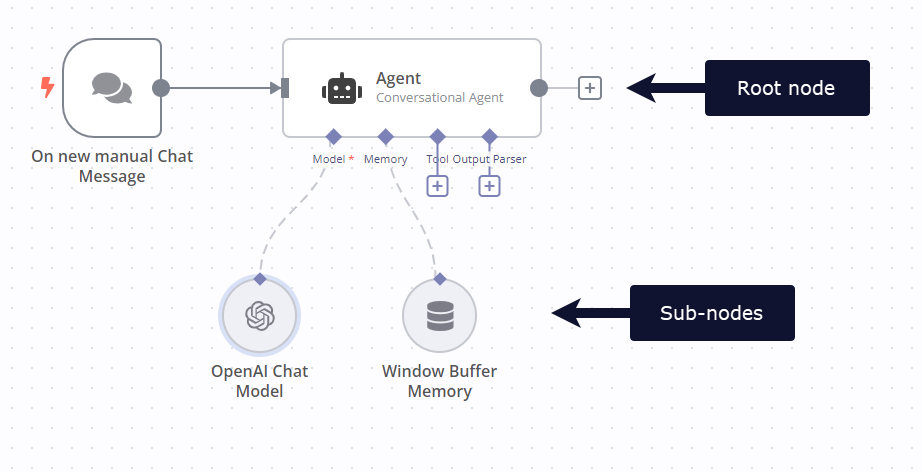LangChain concepts in n8n#
This page explains how LangChain concepts and features map to n8n nodes.
This page includes lists of the LangChain-focused nodes in n8n. You can use any n8n node in a workflow where you interact with LangChain, to link LangChain to other services. The LangChain features uses n8n's Cluster nodes.
n8n implements LangChain JS
This feature is n8n's implementation of LangChain's JavaScript framework.
Trigger nodes#
Cluster nodes#
Cluster nodes are node groups that work together to provide functionality in an n8n workflow. Instead of using a single node, you use a root node and one or more sub-nodes that extend the functionality of the node.
Root nodes#
Each cluster starts with one root node.
Chains#
A chain is a series of LLMs, and related tools, linked together to support functionality that can't be provided by a single LLM alone.
Available nodes:
Learn more about Chains in LangChain.
Agents#
An agent has access to a suite of tools, and determines which ones to use depending on the user input. Agents can use multiple tools, and use the output of one tool as the input to the next. Source
Available nodes:
Learn more about Agents in LangChain.
Vector stores#
Vector stores store embedded data, and perform vector searches on it.
- In Memory Vector Store
- Pinecone Vector Store
- Qdrant Vector Store
- Supabase Vector Store
- Zep Vector Store
Learn more about Vector stores in LangChain.
Miscellaneous#
Utility nodes.
LangChain Code: import LangChain. This means if there is functionality you need that n8n hasn't created a node for, you can still use it.
Sub-nodes#
Each root node can have one or more sub-nodes attached to it.
Document loaders#
Document loaders add data to your chain as documents. The data source can be a file or web service.
Available nodes:
Learn more about Document loaders in LangChain.
Language models#
LLMs (large language models) are programs that analyze datasets. They're the key element of working with AI.
Available nodes:
- Anthropic Chat Model
- AWS Bedrock Chat Model
- Cohere Model
- Google PaLM Chat Model
- Google PaLM Language Model
- Hugging Face Inference Model
- Mistral Cloud Chat Model
- Ollama Chat Model
- Ollama Model
- OpenAI Chat Model
- OpenAI Model
Learn more about Language models in LangChain.
Memory#
Memory retains information about previous queries in a series of queries. For example, when a user interacts with a chat model, it's useful if your application can remember and call on the full conversation, not just the most recent query entered by the user.
Available nodes:
Learn more about Memory in LangChain.
Output parsers#
Output parsers take the text generated by an LLM and format it to match the structure you require.
Available nodes:
Learn more about Output parsers in LangChain.
Retrievers#
Text splitters#
Text splitters break down data (documents), making it easier for the LLM to process the information and return accurate results.
Available nodes:
n8n's text splitter nodes implements parts of LangChain's text_splitter API.
Tools#
Utility tools.
Embeddings#
Embeddings capture the "relatedness" of text, images, video, or other types of information. (source)
Available nodes:
- Embeddings AWS Bedrock
- Embeddings Cohere
- Embeddings Google PaLM
- Embeddings Hugging Face Inference
- Embeddings Mistral Cloud
- Embeddings Ollama
- Embeddings OpenAI
Learn more about Text embeddings in LangChain.
